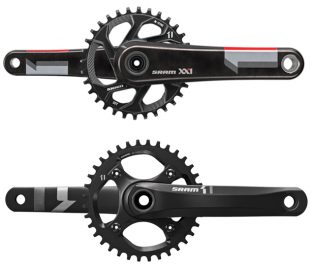Inside Line: RockShox and SRAM introduce Boost components
Originally posted on March 18, 2015 at 20:21 pmThe new product news continues to roll in, with SRAM and RockShox releasing a pile of new parts related to the new Boost axle standards.

Boost 110
Both the 27.5 and 29-inch versions of the Pike, Reba and SID are being made available with a new 110×15 axle standard. The wider forks will allow for the ever-growing tires that riders are using on ever-widening rims, and will make the wheels stiffer due to the spoke bracing angle.

For those readers clamoring for 27plus news, RockShox says the new 29er Boost forks will fit a 27.5×3.0 tire, but to confuse things even further, the Pike fork will also be available in a “standard” 27.5 Boost version as well. All the traditional 15×100 forks will still be available, of course.

The hubs at the heart of the new forks are designed around the Torque Cap, a RockShox/SRAM exclusive technology that uses a larger axle endcap interface between the hub and fork. It is not to be confused with the Torque Tube Axle from the RS-1 fork (though we don’t blame you if it is). It isn’t clear yet if these new forks will work with non-Torque Cap hubs, or if Torque Cap hubs will work with other manufacturer’s 110×15 forks. So much Torque! We reached out to SRAM to clarify and we’ll update when we hear back. It is also not clear if hubs are cross-compatible with the new 15×110 Fox forks announced last week.

If you’re wondering if you can space out a 15×100 hub with custom end caps to work with the Boost forks, the answer is probably not because the brake caliper won’t line up with the rotor. You could possibly create an adapter to move the caliper inboard, but once you go down that rabbit hole who knows what is possible.
Boost 148
The Boost 148 standard was introduced last year on the new Trek Remedy and Fuel EX as a way to increase the stiffness and strength of a 29er wheel, improve clearance for chainring and suspension pivots and increase tire clearance, all without changing the bottom bracket or Q-factor.

This is accomplished by spreading the hub flanges 3 mm each, and widening the axle by 6 mm. This pushes out the chainline an additional 3 mm, which is easily handled with a offset chainring for the SRAM modular crank system. RockShox says a 29er wheel built on a Boost 148 hub is as stiff as a 27.5 wheel built on a 142 hub.

If you’re wondering why not just go with a 150mm downhill hub, it’s because those hubs actually measure 157mm with the flanges, and were deemed too wide to work with a standard 73mm bottom bracket spacing.


We’ll see Boost 148 cranks at the XX1 and X1 level, along with Rise 40 wheelsets (with matching 110×15 front hub) in 27.5 and 29. Two levels of hubs will be ready this summer: XO or MTH 700, which uses the same internals as an X9 hub. Both hubs have the option of an XD driver or 8/9/10 speed Shimano splined cassette body.

What’s next
SRAM was quick to support the fat bike market with drivetrain parts and the Bluto fork, and seem to be lined up the same way for the 27plus movement. While the new Boost products were not designed specifically for the mid-fat wheels, they certainly make it easier to work with them. But what bike(s) will they go on? Chances are we will find out soon.
And will Shimano come on board with parts to support the Boost standard? With the launch of the 2016 XT group at Sea Otter we should have an answer soon.